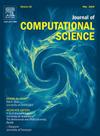Spatio-temporal consistency of cloud-microphysical parameter sensitivity in a warm-conveyor belt
IF 3.7
3区 计算机科学
Q2 COMPUTER SCIENCE, INTERDISCIPLINARY APPLICATIONS
引用次数: 0
Abstract
A good representation of clouds and precipitation processes is essential in numerical weather and climate models. Subgrid-scale processes, such as cloud physics, are parameterized and inherently introduce uncertainty into models. Traditionally, the sensitivities of the model state to specific uncertain parameters are quantified through perturbations to a few selected parameters, limited by computational resources. Algorithmic Differentiation (AD) enables the efficient and simultaneous estimation of sensitivities for a large number of parameters, thereby overcoming the previous limitations and significantly enhancing the efficiency of the analysis. This framework provides an objective way to identify processes where more precise representations have the largest impact on model accuracy. AD-estimated sensitivities can also address the underdispersiveness of perturbed ensemble simulations by guiding the parameter selection or the perturbation itself. In our study, we applied AD to 169 uncertain parameters identified in the two-moment microphysics scheme of the numerical weather prediction (NWP) model ICON of the German Weather Service. This application of AD allowed us to evaluate the sensitivities of specific humidity, latent heating, and latent cooling along several thousand warm conveyor belt trajectories. This coherent, strongly ascending Lagrangian flow feature is crucial for the cloud and precipitation structure and the evolution of extratropical cyclones. The quantification of individual parameter sensitivities shows that only 38 parameters are of primary importance for the investigated model state variables. These parameters are associated with rain evaporation, hydrometeor diameter-mass relations, and fall velocities. Moreover, the parameter sensitivities systematically vary with different microphysical regimes, ascent behavior, and ascent stages of the WCB airstream. Finally, several parameters impact an extended region in the extratropical cyclone, illustrating the spatiotemporal consistency of cloud microphysical parameter uncertainty in the applied NWP model and microphysics scheme.
热传送带中云微物理参数灵敏度的时空一致性
在数值天气和气候模式中,云和降水过程的良好表现是必不可少的。子网格尺度过程,如云物理,是参数化的,固有地给模型引入不确定性。传统上,受计算资源的限制,模型状态对特定不确定参数的敏感性是通过对几个选定参数的扰动来量化的。算法微分法(Algorithmic Differentiation, AD)能够对大量参数进行高效、同步的灵敏度估计,从而克服了以往的局限性,显著提高了分析效率。该框架提供了一种客观的方法来识别更精确的表示对模型准确性影响最大的过程。ad估计的灵敏度还可以通过指导参数选择或扰动本身来解决摄动系综模拟的欠色散问题。在我们的研究中,我们将AD应用于德国气象局数值天气预报(NWP)模式ICON的双矩微物理方案中识别的169个不确定参数。AD的这种应用使我们能够评估特定湿度、潜在加热和潜在冷却的敏感性,沿着数千条温暖的传送带轨迹。这种连贯的、强上升的拉格朗日流特征对云和降水结构以及温带气旋的演变至关重要。单个参数敏感性的量化表明,对于所研究的模型状态变量,只有38个参数是最重要的。这些参数与雨蒸发、水流星直径-质量关系和下落速度有关。此外,参数敏感性随WCB气流的不同微物理状态、上升行为和上升阶段而系统变化。最后,几个参数影响了温带气旋的扩展区域,说明了应用NWP模式和微物理方案下云微物理参数不确定性的时空一致性。
本文章由计算机程序翻译,如有差异,请以英文原文为准。
求助全文
约1分钟内获得全文
求助全文
来源期刊

Journal of Computational Science
COMPUTER SCIENCE, INTERDISCIPLINARY APPLICATIONS-COMPUTER SCIENCE, THEORY & METHODS
CiteScore
5.50
自引率
3.00%
发文量
227
审稿时长
41 days
期刊介绍:
Computational Science is a rapidly growing multi- and interdisciplinary field that uses advanced computing and data analysis to understand and solve complex problems. It has reached a level of predictive capability that now firmly complements the traditional pillars of experimentation and theory.
The recent advances in experimental techniques such as detectors, on-line sensor networks and high-resolution imaging techniques, have opened up new windows into physical and biological processes at many levels of detail. The resulting data explosion allows for detailed data driven modeling and simulation.
This new discipline in science combines computational thinking, modern computational methods, devices and collateral technologies to address problems far beyond the scope of traditional numerical methods.
Computational science typically unifies three distinct elements:
• Modeling, Algorithms and Simulations (e.g. numerical and non-numerical, discrete and continuous);
• Software developed to solve science (e.g., biological, physical, and social), engineering, medicine, and humanities problems;
• Computer and information science that develops and optimizes the advanced system hardware, software, networking, and data management components (e.g. problem solving environments).
 求助内容:
求助内容: 应助结果提醒方式:
应助结果提醒方式:


